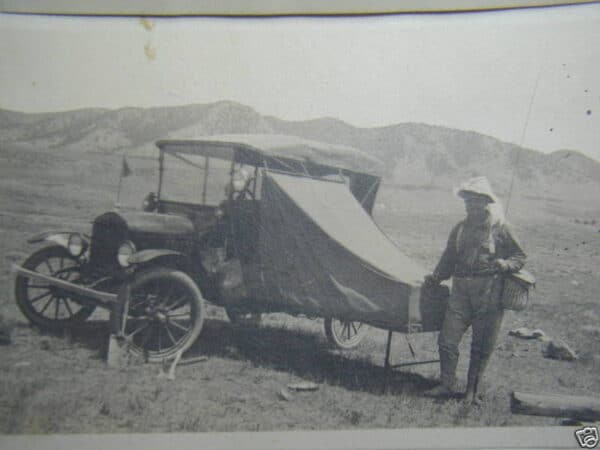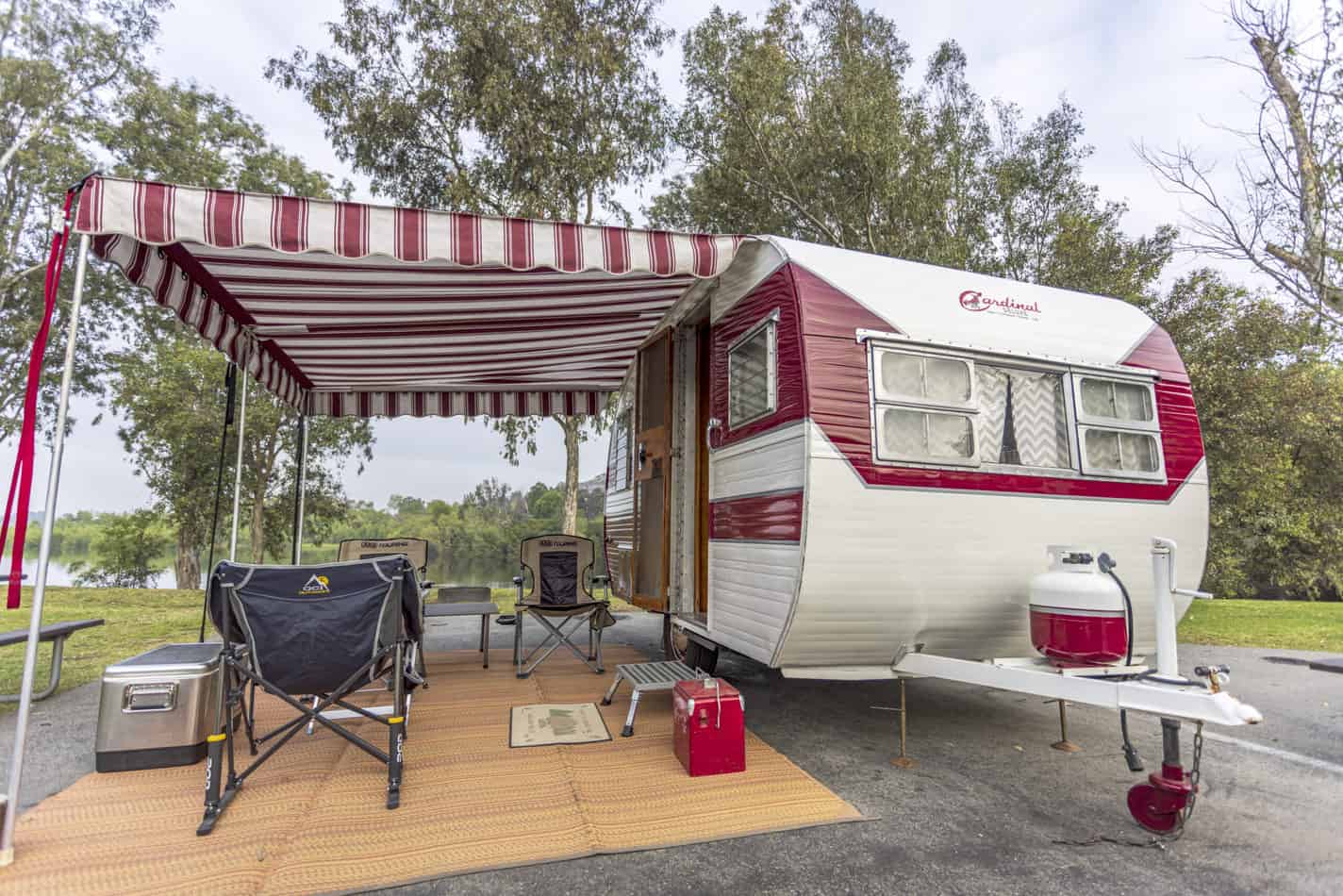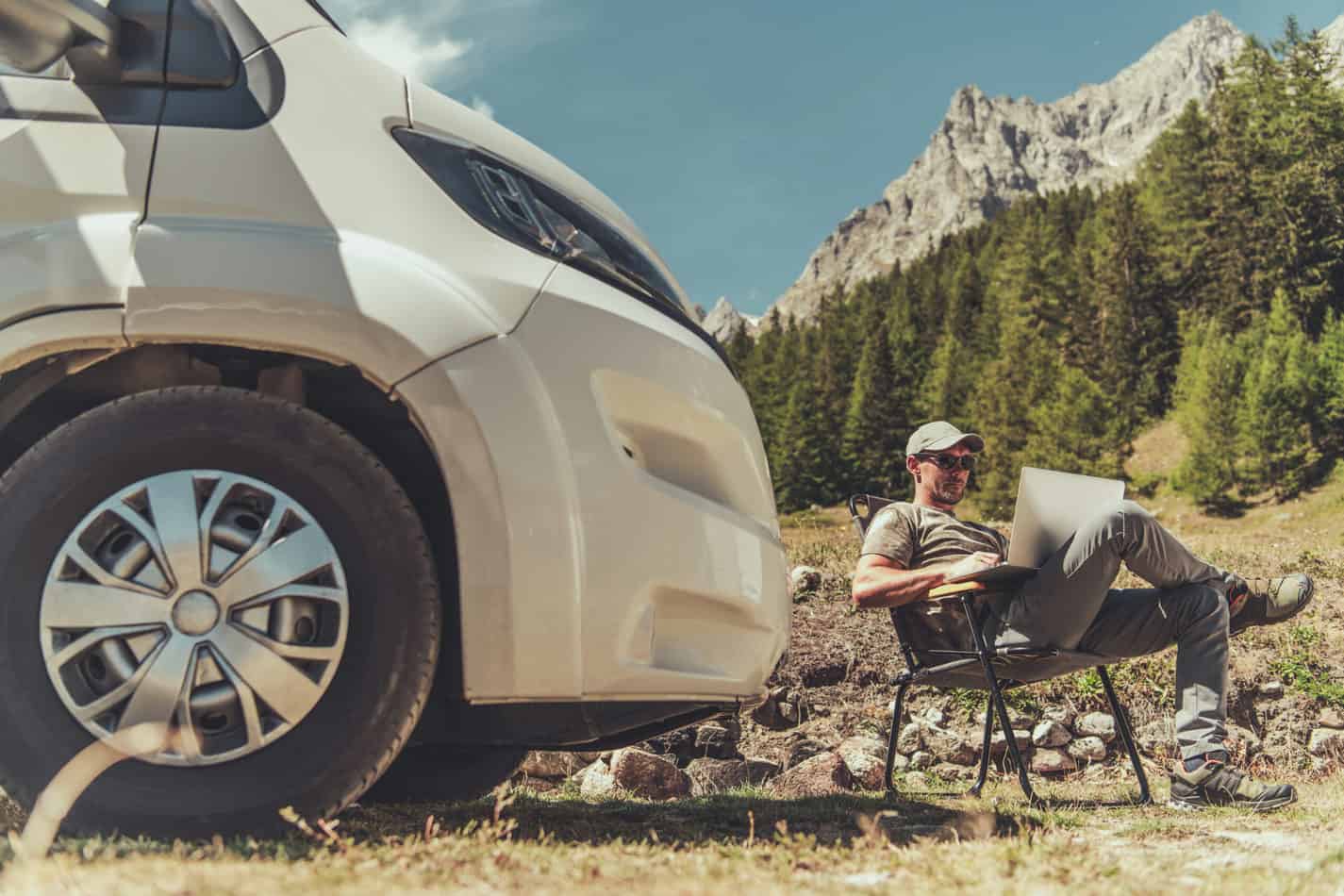If you’re the proud owner of an RV made after 2008, then you have a motorhome or travel trailer from RV history known as the Modern Era. There was a moment in time where the RV you’re sitting in almost didn’t exist. One world-changing event nearly wiped out the entire RV Industry. Another cataclysm turned the RV Industry into personal protection equipment triggering an RV Boom never seen before.
Come with us as we make our way through the Modern Era. We’ll show the technology and overall changes the industry made. Some changes were gradual, while others took a sharp left turn, creating a new RV design perspective. Some advances reintroduced camping concepts seen over 100 years ago in the Antique Era (1910-1944).
If this is your first time delving into our RV History Series, we recommend starting with the Antique Era to gain the complete perspective of how far the technology has come (they’re older than you think). Then continue to the days of the first mass-produced motorhomes and iconic canned ham travel trailers during the Vintage Era’s (1945-1970).
If you’re a child of the 1980s, you’ll enjoy the Classic Era (1971-1989) because you may remember growing up around many of the featured RVs. The Neo-Classic Era (1990-2007) should be highly attractive to you because your inner child will love the many Classic Era concepts still in use, but the grown-up will enjoy the new tech like the slideouts and bunkhouse floorplans for your legacy RVers.
RV History: The 2008 Financial Crisis
The Almost Extinction Level Event for the RV Industry
According to the Harvard Business Review, the 2008 Financial Crisis cost the average American $70,000. Investment banks fell, corporations received government loans to stay afloat, and other macroeconomic events dominoed across the world. People lost their jobs, homes, and the essential bills like utilities and food became a struggle to maintain. The personal watercraft and RV Industries were hurt badly. Many RV dealerships had to close their doors for two reasons: Lack of sales and banks pulling away from RV financing. Those that survived were lucky enough to have lenders willing to take on the risk or had other factors that kept them going.
Over 15 RV brands filed for bankruptcy between 2008-2009. These weren’t little names. Companies like Country Coach, Fleetwood Motor Homes, Monaco Coach, Rexhall RV, and Travel Supreme filed since they couldn’t maintain themselves through these lean times. During this time, the Big 4 (Forest River Inc., REV Group, THOR Ind., and Winnebago Outdoors) found opportunities in the Financial Crisis. REV Group and Thor Industries brought on some of those companies in need. The parent companies restructured the business side of the operation and opened doors for shared technology and suppliers. Forest River Incorporated slowed production but kept the dream alive. The shape of RV history began to change.
Winnebago (known as Winnebago Industries) decided to push the red button to stop production. Typically, production lines stop for two weeks at a designated point during the year so that the engineering team can retool for the next model year production. Winnie took a few months off to shake off the past. What they presented for the 2010 model year was a super-sized rebranding that knocked everyone off their feet.
Uncle Sam Walks Into the 2009 RV Show and Falls From Shock
Uncle Sam became the personification of the United States as early as the War of 1812. Modeled off, Samuel Wilson, a meatpacker from Troy, New York, supplied troops with rations during the war. Since then, his image has represented patriotism, American Tradition, and the U.S. Government. (By the way, a million imaginary points if you can name something else that came from the War of 1812- your clue is, it’s sung at the beginning of every sports event).
While the World and the United States were slowly recovering from the Financial Crisis in 2009, The various state RV Trade Associations held their RV shows to introduce the 2010 model years. The “Belle of the Ball” came from the least expected brand anyone would have thought of: Winnebago. Their Minnie Winnie travel trailer made its own RV history and stood out like a beacon with an all-red fiberglass panel exterior. Sorry, Uncle Sam, your trusted RV brand went “punk” on you.
Disrupting the White and Beige Exterior Axiom
Other brands started playing with exterior colors once Winnebago released the red exterior (it also came in blue, green, white, and black). Top-end luxury Class A motorhomes were already starting to use color choices that played in the monochrome, earth tone, and other spectrums. Winnebago essentially said to the RV World, towables can do that too.
Modern and Contemporary Interiors
RV sales had a steady sales increase from 2012-2017. It “hiccuped” in 2018 but really sky-rocketed in 2020 (which we’ll talk about later). Since the late Vintage Era (1945-1970), the Classic Farmhouse Interior Design Style became a staple for RVs. Younger generations started to have an issue with this idea. Like the Canned-Ham trailers of the 1950s, young families and couples wanted an interior that reflected the modern and contemporary designs seen in their residential homes. Some of the 2010 models focused on the younger generations’ interior preferences. Soon they became so popular; the classic farmhouse style became the optional decor.
RV History: Outdoor Kitchens
Motorhomes, fifth wheels, and travel trailers with outdoor kitchens developed since bunkhouse floorplans allowed for shared interior space for the bay. The evolution of the outdoor kitchen came from the barbecue side rail feature. Having a sink, stovetop, refrigerator, and storage further developed the outdoor living space making tailgating and get-togethers much better.
All Hail the King, Long Live the Queen
RVers always prefer more bed space. Whether it’s for the family pet or more shoulder room, the 76 x 80-inch mattress made sleeping so much better than the 60 x 80-inch queen. Class A motorhomes, full-profile fifth wheels, and full-length travel trailers started offering king-size beds as a standard feature. When it wasn’t possible, RV manufacturers would do their best to create floorplans to make residential queens a reality.
COVID-19 Helps Accelerate the Modern RV Boom
Before 2019, most people considered the idea of a worldwide disease causing millions of casualties as science fiction entertainment or Homeland Security hypothetical preparation. After the U.S. enjoyed the holiday season, the media started talking about a virus called the Coronavirus or COVID-19. RV History would change again, and fast.
By April 2020, the entire world was under a stay-at-home curfew. Only essential workers- medical staff, first-responders, utility services, the media, food services, and others could leave their homes to provide their necessary trades. The RV Industry was one of the first to step up to help out. Various RV brands donated travel trailers to act as mobile triage units and homes for infected first-responders. RV rental companies reduced rates, so utility workers who couldn’t leave the facility had a place to stay after their shift. Other peer-to-peer RV rental companies gave special one-way rates to vacationers who needed to get home. Since the airlines were grounded, these people used motorhomes and travel trailers to drive home safely in something that kept them self-contained and socially distant.
Once the curfew lifted, those RV renters told their friends about the rental experience and became RV buyers. Once the stay-at-home curfew lifted, RV rentals jumped 1,000%, and sales soared 600% in the summer of 2020. By the end of the year, the RV Industry saw an unheard-of 30% increase in sales. RV campgrounds quickly became filled up. Before 2020, full-timers and veteran RVers could make reservations a week or two ahead of time or pull into a lesser-known campground. With the surge of new first-time RVers, everyone had to adapt to make a reservation up to 3-4 months ahead of time. It became so overwhelming; some entrepreneurial spirits would get in trouble selling their campground reservation to others for rates many times higher than the original price.
Once the RV Boom was in full swing, a portion of popular dispersed camping sites on National Forest and Park land was closed down by the National Park Service (NPS) due to non-adherence to NPS policy. Bureau of Land Management (BLM) areas became as populated as the sold-out campgrounds.
RV History: The Office Workspace
Another effect of the RV Boom was the rapid increase in those joining the full-time RV Life. Before 2020, there were roughly one million full-timers on the road. From May 2020 to April 2021, that number virtually doubled. When the stay-at-home curfew lifted but the world waited for the COVID-19 vaccine, the economy had to shift into gear. Office workers couldn’t go back to work due to social distancing concerns. Many employers had their I.T. departments develop work-from-home techniques. Once the system was up and running, employees could get back to work in the safety of their own homes.
Those that enjoyed the RV lifestyle and wanted to take it to the next level saw an opportunity. Using wireless cellular or satellite technology, data boosters, and other devices, they wired up their RV. These new full-time RVers brought their work-from-home jobs on the road with them. The final piece to the puzzle was finding a coach that had a designated space to set up a computer and other peripherals to perform their work tasks. Hearing their customer base, the RV Industry tasked their engineering teams to expand on the idea. Before this time, many Class A motorhomes had pull-out trays for the co-pilot to set up laptops. Now, there are office spaces so well designed; they feel like an executive’s corner office, as seen in Airstream’s first workspace RV, the Flying Cloud 30RB Office.
Old is New Again With Antique Era Car Tent Concepts

In the picture above, the fisherman is standing next to his 1915 L.F. Shilling Auto Camp. It’s attached to his Ford Model T driver’s side and has a wood platform for a base. Other versions of the Auto Camp made dispersed camping possible (although camping with utilities wouldn’t show up for another 40 years).
What makes the RV history of the Auto Camp so fascinating in the Modern Era is that its back. Today’s car campers are tents that attach to the back or roof of an SUV. Some tents expand above pickup truck cargo bed caps. These camping devices sit on the line between the #TentLife and RVs. As an RV Historian, we’ll agree that the car tent camper is a wonderful asset to both sides of the fence (yes, but in this situation, cowards live to see another day).
Industry Officials Decide to Level the Playing Field
The late twenty-teens started to get out of hand when it came to new model year release dates. RV manufacturers were so eager to be the first ones to launch the next model year; they started presenting them to the public earlier and earlier. It became so bad that the public would see three model years from the same RV company in a single calendar year.
The RV Industry Association (RVIA) Board of Directors approved a best practice that all RV manufacturers could voluntarily adopt. They agreed to a time frame between July 1- August 31 of every year to use as the transition period for model years. Modeling off the car industry, RV dealers could better prepare for the change, consumers could see the new changes all at once, and there wouldn’t be double transitions in a single calendar year.
Avoiding Reality, But Living In Real-Time
The Millenial Generation makes up over a third of the RV consumer population. A significant portion of them prefer the dispersed off-grid dry camping experience rather than hooking up at a campground. Even though they’re away from the things of humankind, generally, they want to stay connected to their friends and family through social media. For some, it’s a way to share their adventures, and for others, it’s that safe line for unforeseen circumstances. The RV Industry and other sectors have come up with many innovations to make this style of RVing possible.
Solar Panel Energy Independence
In the Modern Era, solar panel technology became the focus for off-grid power. Virtually every RV was pre-wired and had a plug to support the panels. Manufacturers made structural changes on the roof, and the house battery bay as solar became more popular. RV brands started offering 100-150 watt roof panels as standard features.
Solar energy gave new possibilities for those who enjoyed dry camping. It allowed boondockers to stay off the grid longer and cheaper since they didn’t need to run their gas or propane generators for their electrical needs. Running air conditioners with solar panel-generated electricity was still a problem because the A/C units required more power than the panels could produce.
Companies developed solar generators, which were portable lithium-ion batteries that you could charge with solar panels. The generator’s housing had multiple outlets for 110v, USB, and DC connections in virtually every configuration. RVers could use them inside since they didn’t make noise or create any exhaust. Smaller sizes were ideal for charging mobile devices, and larger versions could run electric components like cooking devices, entertainment features, or any other feature for hours at a time.
Off-Road RVs
Off-road packages increase tire sizes and upgrade suspensions so that owners can take the coach on dirt roads and through most terrains. Expedition Vehicles take it to the next level with devices to adjust tire inflation, underbelly plating, and other essentials to climb mountains or wade through swamps.
Phasing Propane Out
After the Financial Crisis, each model year showed a progression of phasing out the use of propane. The symbiotic relationship between the RV Industry and propane components dates back to the Late Antique Era in RV history. Yet, every RVer has always had to keep their eyes open for potential problems on the highly flammable gas.
Today, there are many ways the Industry is phasing propane out. For the 2021 and 2022 model years, we’re starting to see luxury and mid-level units without LP tanks. Here are some of the new technologies that are replacing propane components:
- Electric or induction stovetops
- Convection microwaves
- Aqua-Hot heating systems
- Electric water heaters
- Electric furnaces
- Air conditioners with heat pump strips
- Residential refrigerators or 12 volt RV refrigerators that run on shore power or the batteries
- LED faux fireplaces with 5,000 BTU electric heaters
With an Aqua-Hot, convection microwave, and electric stovetop, motorhomes and travel trailers could operate without propane. Campers and small travel trailers still relied on propane for heating, hot water, and cooking since it was a cheaper method. The expectation moving forward would be to continue this LP-less trend through all RV categories.
Wireless Alarm Systems
We discussed how wireless telecommunication technology made working from an RV possible, but it also allowed people to keep their home on wheels safe. Wireless residential home alarm systems like Reolink, Ring, SimpliSafe, and Tattletale made remote boondocking safer. Complex systems offered cameras, detectors, and sensors that alerted RV owners on their mobile devices whether they were home or away. Alerts would warn if there were a security issue, disaster, or if they just wanted to check in on things. Cameras or other devices would offer two-way communication and/or recorded video.
The Mad Russian Was Right
In the late 1800s, Serbian Physicist Nikola Tesla made incredible advances with electricity production and its uses. Erroneously nicknamed “The Mad Russian,” he believed that every automobile, industrial factory, and power station could run off his electric engine that produced DC power. It just needed the proper funding and further development. Unfortunately, once german inventors Nicolaus Otto, Gottlieb Daimler, and Wilhelm Maybach developed their 4-cylinder gas-powered engine in 1876, vehicles and industry went with fossil fuels. The technology had horsepower, torque and was available immediately. Tesla’s electric motor concept did become a reality but ended up in appliances, some industrial applications, and toys.
Thomas Edison experimented with an electric car in 1908, and GM spent some time on a prototype during the 1973 Gas Crisis, but it would be the Japanese that would kick off the electric vehicle age. Honda released its 2 passenger Insight in 1999, but the 2000 Toyota Prius Hybrid marked the new age of America’s acceptance of hybrid electric car acceptance.
In 2006 a car company named after the misunderstood Serbian realized his dream by creating the first all-electric luxury car that could drive over 200 miles. Tesla motors paved the way for the Chevy Volt (pure electric version), Nissan Leaf, and others. When we wrote this article, most EV truck companies have sold out first-generation truck waiting lists.
2022 RV model year will end with some of these EV trucks pulling travel trailers to local campgrounds. Many EV trucks have towing and payload capacities around 7,500 pounds and driving distances between 200-300 miles. The RV industry is developing different ideas to compensate for the 50% distance loss from the RV’s weight. One is adding a second battery bay that feeds the truck’s batteries through the umbilical cord for additional power.
Camping World and Lordstown created a partnership to create a new drivable RV category called the Class E. The motorhome would use a full-size van chassis, like the Class B, but the automotive and coach sections shared the batteries. When we wrote this article, the first generation of EV trucks had sold out waiting lists and were in their final testing phases. The Class E RV still exists as a concept, but we look forward to our first walkthrough.
The Best Way to Buy a New RV in the Backlog Market is to Hurry Up and Wait.
If you hear someone say they had to wait four months to get their new RV because COVID-19 created the part shortages in the RV Industry, they’re oversimplifying. The Pandemic shut down the production lines in Elkhart, Indiana, around six weeks, during the stay-at-home curfew, but there’s a lot more to it. Elkhart was a hot zone for the virus, so for most of 2020, the production lines weren’t at full staff. That didn’t mean too much because many third-party vendors that produce the components that RVs use had problems of their own. If you look at the thousands of parts, your RV contains, other companies create those parts from the tiny screws to the suspension.
On February 13-17, 2021, Texas suffered from an ice storm. The parts of Texas that were affected don’t usually see that type of weather. The sudden drop in temperature changed the overall climate to Louisiana. In this region, foam insulation producers chose this part of the United States because the conditions are ideal for the foam to cure correctly. With the weather change, these companies lost weeks of production and product that was curing. Other raw material sectors fell behind due to various issues. Lumber, water heaters, and fiberglass are some of the major vendors. At first, RV manufacturers substituted upgrades where they could. When that option wasn’t possible, they started lining up the coaches in their plant lots.
For the 2021 model year, the general guideline was that customer orders had top priority. If there was time to produce a dealer stock unit, then the manufacturer would make it. For 2022, many of the RV brands trimmed down their catalogs, offering fewer floorplans, sizes, and other variations. The idea was to decrease the backlog with fewer variations and allow third-party vendors to catch up by sticking to fewer models of their components.
RV History: Defining Our Modern Era
When we lived in the Neo-Classic Era, we considered that as the Modern Era. Once we flip the page into the next RV Era, what will be our current Modern Era name? Will we call it the Energy Independence Era since we advanced solar power and decreased propane and fossil fuel?
Should we call it the Eventful Era since we had two world-altering events that changed everything, including how the RV Industry operates? We’d prefer to take a more positive approach. When the RVIA published their survey in May 2021 that said over 56 million people plan to take an RV vacation in 2021, Craig Kirby, President and CEO of the RVIA, stated;
“RVing has been cemented as a mainstream travel option that is here to stay.”
With RV sales increasing for almost every year in this Era, over 30% in 2020 alone, maybe we’ll eventually call our current Modern Era the “Mainstream Era.” Despite the enormous tragedies, or because of them, the RV lifestyle returned to the hearts and minds of enough Americans to make it a major pastime again.
What’s ahead in our RV History Series
We at Camper Smarts and RV LIFE want to thank you for taking the time to walk with us down the RV history highway. We hope you learned a lot and had as much fun as we did. The best part was imagining ourselves in many of those RVs. There’s still plenty more RV history to explore, so we’re far from the finish line. In the upcoming months, we’re going to delve into the creation and early years of the Big 4; Forest River Inc., REV Group, Thor Ind., and Winnebago Ind.
We’re also going to wander through the best National Parks and how they became a part of our National history. Before we do that, we’re going to pull up our jacks and journey down the roads where many of us RVers earn our stripes. The Alcan Highway, I-90, the longest highway in America, and other roadways of significance. Of course, if we’re going to discuss the great American roadways, we have to start with The Mother Road. Join us next time as we heed her voice because Momma’s Callin’ on Route 66.





Great article! Thanks
SUELLEN:
Thank you so much. I really enjoyed writing this era series. I hope you and everyone else are looking forward to the next series of RV History pieces.
If you’ve never had any experience with camping or even owned a small towable before, maybe renting one BEFORE you buy is a good idea. I really can’t believe someone buying an RV and discovering shortly after that they “hate” to RV…. that’s terrible.
I think these folks made a lot of good points, and there’s always going to be some ebb and flow in the market for this kind of product. There’s a very “romantic” notion of going on the road, but, it does take a certain amount of work, it’s not like just pulling up to a hotel. And, if you don’t like “driving” , please do not get an RV. Finally, RV’s are complicated pieces of machinery, it’s a house on wheels and things go wrong. You have to really adjust your attitude and “try to not get upset” when things fail. It’s easier said than done. I’m getting better at this, but, some failures are “show stoppers” and your RV can sometimes wind up being your “Ruined Vacation”.
Usually with most products , you always look for the best ” Made in the USA ” , this does not apply to the RV industry . It is nothing short of criminal what they manufacture , sell and put onto the highways in America . Buyers Beware you are about to make the worst investment of your entire life . You are being sold a dream in exchange for your hard earned money that may have taken a lifetime to accumulate . Enjoy your Retirement .
The ERA just before 2007 might also be called the Quality Era.. when small companies
emphasized quality, then the corporate buy outs began and quality was replaced with bottom lines .. and cutting corners.
A well-ballanced and informative presentation.
Wow…one of the best articles on RVs and RVing I’ve ever read.
Thank you!
Fascinating article. We didn’t realize all that when we were hunting for a travel trailer last fall. Now that we are waiting on a new Class A (from Elkhart, of course) this explains a lot!
Tesla linvented the dynamo/generator that produced our modern AC power system. Edison was the one who promoted a DC power grid that required a generating station for each square-mile area.
I had a 2008 39 foot pusher that was used when I bought it. I had some problems but nothing like what comes off the production lines today. I really want to travel in my retirement but I hear horror stories about rigs just falling apart in the first couple of days. I think I will pass on buying another until the quality control improves which may never happen.
And in spite of all the ups and downs and new features, quality is still poorer then when we started buying campers in the late 80s. For all the wahooing and chest beating about sales in the industry no one shouts about how much (or how little) their quality has changed using factual data or customer feedback surveys.
That was a fun and interesting read, thank you.
RV mfg. quality certainly needs to improve as this early spring of 2021, discovered a minor roof leak in the front on the passenger side of my 2017 Keystone compact TT. Did not use my TT in 2020 due to some minor physical health issues that surfaced in late 2019 that lasted through most of 2020 along with the pandemic closures. Could not check the roof of my RV in 2020 and did not think it would be an issue since got it new in March 2017 and it was mfd. in November 2016. Patched it up with some Flex Seal, seems to be holding up for now. As an RV YouTuber said, there’s no excuse that RV Mfgs. do not use better construction methods and materials that would create for a much better product at minimal cost to them.
STEVE:
Thanks for adding your comments about Tesla and Edison. When I was writing about Nikola, I became so involved in his story, I realized I had used a lot of page “real estate” on points that, while fascinating, weren’t directly relevant to the main topic. I often wonder what our world would be like if Tesla had a good PR person? Edison did great things with GE, but what would Tesla’s company do differently? Would we have seen the all-electric motorhome in a previous era?
KATHLENE:
If you’re referring to the part shortages and backlog issues it does get complex. To keep things straight, I pulled out my 3×5 cards and some scotch tape. I used one of my motorhome walls like one of those dry erase boards you see on police detective TV shows to map everything out. After explaining to my wife why I was ruining her wall (the tape didn’t harm anything), she understood. Then reminded me I had to condense it into a handful of paragraphs. Like any good cop show, the coffee was flowing 🙂
I ordered an RV in 2019 from Embassy RV and took delivery on 12/2020, mine is on an AWD Transit and has no wood and no propane, and no tanks outside the van. I have a UL listed Lithonics Lithium system I love and never have to plug into anything. I loved your history of RVs and the ups and downs. Very informative.
The post 2008 period is better described as the poor quality, EPA engine restricted, post “great recession” years for class A diesel motor coaches. The 2002 thru 2006 period, before the EPA diesel engines, were the best years for a quality multi-slide diesel coach from manufacturers such as Monaco, Beaver/Monaco, Country Coach, Holiday Rambler and Newmar high end models. The best 2002-2006 models were the Monaco Signature, Monaco Dynasty, Holiday Rambler Navigator, Beaver Marquis and County Coach Affinity or Magna. Buyers are better off buying a 2002 thru 2006 diesel coach of the above named brands/models in the $80K to $180K range in good condition and update it (parts and service are readily available) if necessary than purchasing the inferior quality coaches produced by present manufacturers with the exception of the Newell, Prevost converters and Foretravel coaches which approach selling prices of $1MM new. I have owned 7 diesel pusher high end coaches manufactured by Monaco, Beaver, Holiday Rambler and Country Coach and am the former CEO of a public diesel bus chassis manufacturing company. Take your mechanic along with you on shopping trips and compare the above mentioned older coaches with the newer model coaches and see what your mechanic says about quality.
Very interesting and informative series of articles.
Great read.
People saying that everything built now is poor quality are wrong. I have a 2018 Newmar Dutchstar and it has been the best out of 2 gas and 4 diesel coaches. My last 2 coaches were a 1998 American Tradition and a 2008 Newmar Kountry Star. If you think older is better you are wrong. The advancements made every decade are amazing. To simply say everything built now is nonsense. Very trouble free and very high tech coach. You get what you pay for and don’t need a Newell or Foretravel.